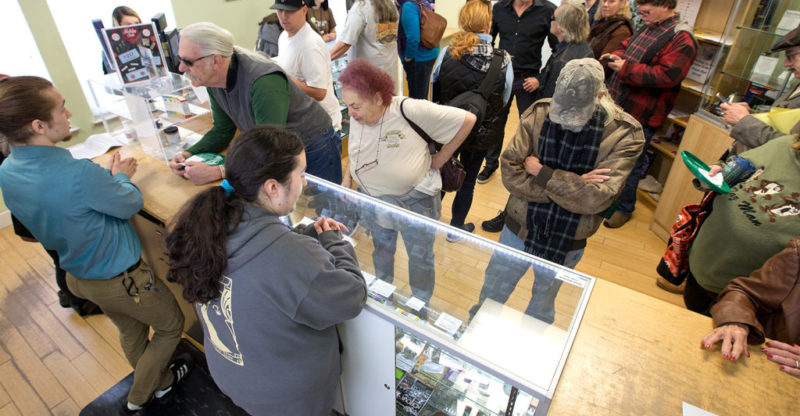Less than 24 hours before the doors to Sebastopol’s Sparc cannabis dispensary were slated to open for recreational marijuana purchases CEO Erich Pearson still hadn’t gotten the official green light. For more than a decade the iconic Sonoma County medical marijuana shop had served the community, but with the state legalization of recreational marijuana in 2016 and 18 months of red tape, January 1 would finally be the day that anyone over 21 could buy cannabis in the state of California — if the permits came through.
But by late Sunday night, according to Pearson, he and about 400 other cannabis dispensaries throughout the state had the go-ahead from both state and local officials to open to the public. At 10:30a.m. New Year’s Day, Sparc became one of the first recreational cannabis stores in Sonoma County. By 11 a.m., nearby Solful dispensary was also open to the public, a result of an emergency ordinance passed in the town of Sebastopol for recreational sales. Mercy Wellness in Cotati got the distinction of being the first to open in the county at 9a.m., while the historic Harborside dispensary opened at 6 a.m. in Oakland.

Erich Pearson with Mike Benziger and Michael Coats at Sparc in Sebastopol. Courtesy photo.
“It’s so special. It’s so great that as a community we’ve worked so hard to get there. We still have a lot of work to do, and a responsibility to make sure this works,” said Pearson, as dozens of excited adult use and medical patients lined up outside the dispensary.
For many medical users and hopeful recreational users, the landscape has been blurry, even until late last week when temporary licenses came through for retailers. Sometimes confusing state legislation, which came out in reams over the last nine months had many in the industry scratching their heads or up in arms. Adding to that were county and city ordinances that stipulated additional rules and permitting. Setting up adult use rules, even for a state with longtime medical use and roadmaps from the already-legal states like Colorado, Washington and Oregon proved challenging.
Standing inside Sparc, however, as the first buyers made their selections, the fog lifted, and exactly how recreational and medical use will work became clearer, though there are years of learning ahead.
“We’ve come a long way from six years ago when we were getting thrown in jail for doing this,” said Pearson. A long way, baby.

Customers shop for a variety of cannabis products on the first day legal recreational marijuana in Sonoma County at SPARC/Peace in Medicine in Sebastopol on Monday morning, January 1, 2018. (photo by John Burgess/The Press Democrat)
Here’s what you can expect in the coming months as dispensaries open for recreational use…
– You’ll need to show a state ID (like a driver’s license) and register with the dispensary if you are 21 or older. Those under 21 are eligible to purchase cannabis, but a state-issued medical ID will be required.
– Edibles were among the most popular purchases at the dispensary. Recreational users cannot purchase any products containing more than 100mg of THC. That means a whole candy bar or several candies cannot add up to more than 100mg total.
– All products must remain in the packaging before purchase. Longtime users are lamenting this new rule because sight and smell are such a huge part of the high-end cannabis experience. Expensive concentrates, valued for their terpene profiles and consistencies are now a mystery before purchase. On a recent trip to Washington state, we purchased a $58 concentrate that, upon opening, was nothing like the explanation we received in the store — with weak terps and no crystallization. Huge bummer.
– On the plus side, budtenders will need to be more experienced in explaining products, something that’s been hit-or-miss in the past. It’s still a roll-of-the-dice, however.
– Taxes on purchases are 15%, currently.
– If you spend more than $100 a month on cannabis, it’s worth pursuing a state medical ID. The state ID is issued by the Dept. of Public Health, and requires a primary caregiver recommendation. To qualify you’ll need to have one of the following conditions: AIDS; anorexia; arthritis; cachexia (wasting syndrome); cancer; chronic pain; glaucoma; migraine; persistent muscle spasms (e.g., spasms associated with multiple sclerosis); seizures (e.g., epileptic seizures); severe nausea; any other chronic or persistent medical symptom that either substantially limits a person’s ability to conduct one or more of major life activities as defined in the Americans with Disabilities Act of 1990, or if not alleviated, may cause serious harm to the person’s safety, physical, or mental health.
– Packaging is transitioning to being child-proof. Some products are already in child-resistant packaging, but your purchase will be placed in a child-resistant bag.

Pearson speaking to reporter Heather Irwin outside Sparc. Courtesy photo (don’t judge it was 10:30a.m. New Year’s Day).
Our crystal ball: Here’s what we see as the changing profile of dispensaries in the future
– The average purchase at dispensaries will go down. Most other legal states have gone to cheap pre-rolls and commodity flowers to serve their recreational users.
– Edibles will increase, but micro-dosed: Users new to cannabis often look to low-dose edibles for sleep or relaxation, eschewing smoking. Highly stringent laws on edibles will require many manufacturers to change their dosage. We’ll see many new edible companies start up now that the rules are clearer.
– CBD will skyrocket: The hype around this non-psychoactive version of cannabis has many interested in its potential healing properties. Though research is still spotty, many new users are interested in a managed high, or no high at all.
– Vapes are the rage: Extremely discreet, and will little or no smell, vape pens are an easy and relatively inexpensive way to get a managed high. Unlike edibles, which can last up to 6 hours in your system, inhaling marijuana typically lasts an hour or two, and users can find micro-dosed pens that deliver 10mg or less per puff.
– Overall dosage will flatten out: The rush to make stronger and stronger strains and more and more concentrated dabs will level off. Connoisseurs will continue to search out some of the more unique strains and concentrates, but that will become an increasingly specialized group.
Featured Image: Customers shop for a variety of cannabis products on the first day legal recreational marijuana in Sonoma County at SPARC/Peace in Medicine in Sebastopol on Monday morning, January 1, 2018. (photo by John Burgess/The Press Democrat)








